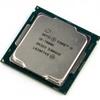The Intel IGP Architecture
The integrated HD graphics engine
The IGP inside the processor is called the Intel Graphics Media Accelerator HD, and is derived from existing Intel graphics products, but has some nice new improvements. The embedded graphics core is an updated model though revamped, improved and definitely more powerful with an improved video en/decoder now as well. The Intel integrated graphics core is incorporated onto the same die as the CPU, and it also has access to Intel's automatic overclocking Turbo Boost features.
Intel HD Graphics is a series of Intel's integrated graphics processors (IGPs) introduced in 2010 that are manufactured on the same package or die as the central processing unit (CPU).
Intel Iris Graphics and Intel Iris Pro Graphics are the IGP series introduced in 2013 with some models of Haswell processors as the high-performance versions of HD Graphics. Iris Pro Graphics was the first in the series to incorporate embedded DRAM.
The Kaby Lake line of processors is expected to retire VGA (DSUB) support. They will support up to five monitors connected via HDMI, DisplayPort or Embedded DisplayPort (eDP) interfaces. The following models of integrated GPU have been announced for Skylake processors:
- GT1 – 12 execution units
- GT1.5 – 18 execution units
- GT2 – 24 execution units
- GT3 – 48 execution units
- GT3e – 48 execution units with 64 MB of eDRAM
- GT4e – 72 execution units with 64 or 128 MB of eDRAM
Haswell processors have up-to 20 EUs, so the performance should be up compared to the previous generation iGPUs. For Skylake and Kaby Lake the minimum number used in the lower end SKUs are 12 EUs, running up-to 72 units for the high end GT4e model. The EUs are arranged in sets of 4 modules. The iGPU is now compatible with DirectX 11.2 and DirectX 12 feature level 11_1, OpenGL 4.4 and OpenCL 2.0. The Quick Sync video encoder has had a speed bump as well and, according to Intel, now offers better quality. For those interested, HEVC hardware decoding support is not embedded. Intel however has a nice workaround, as the drivers support a hybrid decoder that makes use of both the CPU and GPGPU algorithms. Ultra HD screens are supported up-to 60Hz through DisplayPort 1.2, HDMI 2.0 unfortunately is not supported and thus an Ultra HDTV can't be used in 60Hz. Kaby Lake has an interesting and capable GPU, gaming wise you can expect entry-level dedicated graphics performance but we like to see the unit more as a video processor. Very good for stuff like Blu-ray playback and it supports 3D playback thanks to HDMI 1.4a implementation, but not 2.0. It supports Intel Wireless Display (WIDI), will use the embedded DisplayPort standard to connect the GPU to the screen, and is capable of handling the task of transcoding video.
You will have noticed that Intel has been renaming their IGPs, both the Core i5 7600K and Core i7 7700K make use of a 630 designated series IGP. It is the same unit as the Skylake one yet clocked a notch faster and labeled as a Series 630 IGP.
There is one notable enhancement we should mention; on the video processing side of things Intel did make a few new enhancements. For example, if you like to watch Netflix and love ultra HD content, well, Kaby Lake is the one processor series that will support 4k streaming though html5 and, say, the Edge web-browser. Kaby Lake supports the h265-codec and hdcp 2.2. Kaby Lake simply has a new decoding engine compared to previous generations and as such offers an efficient hardware acceleration of 4K content at 10-bits / h265.


